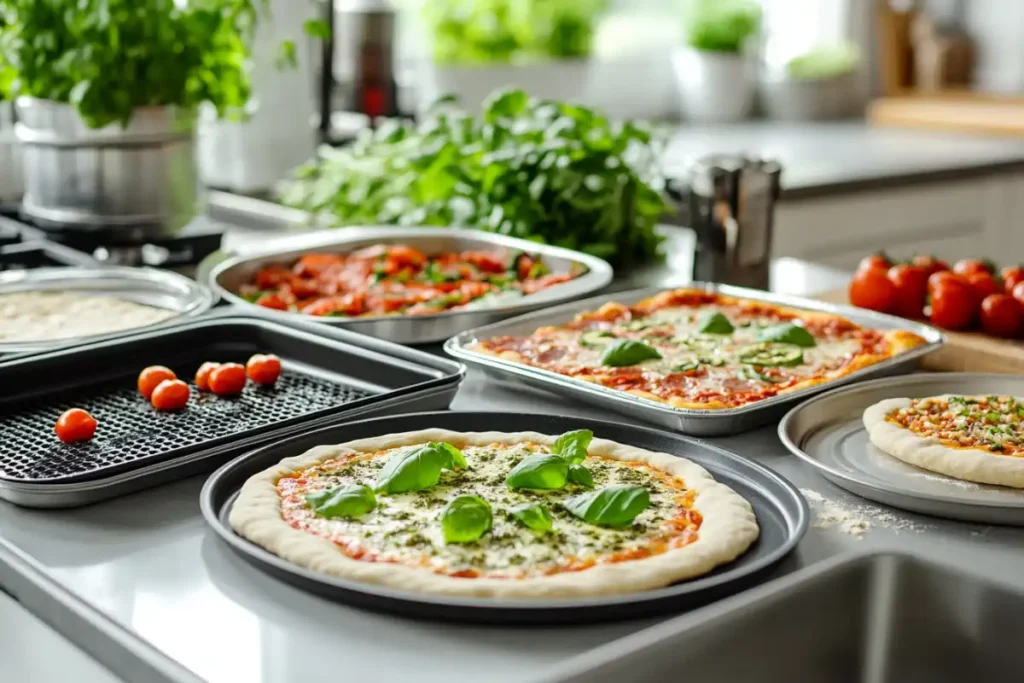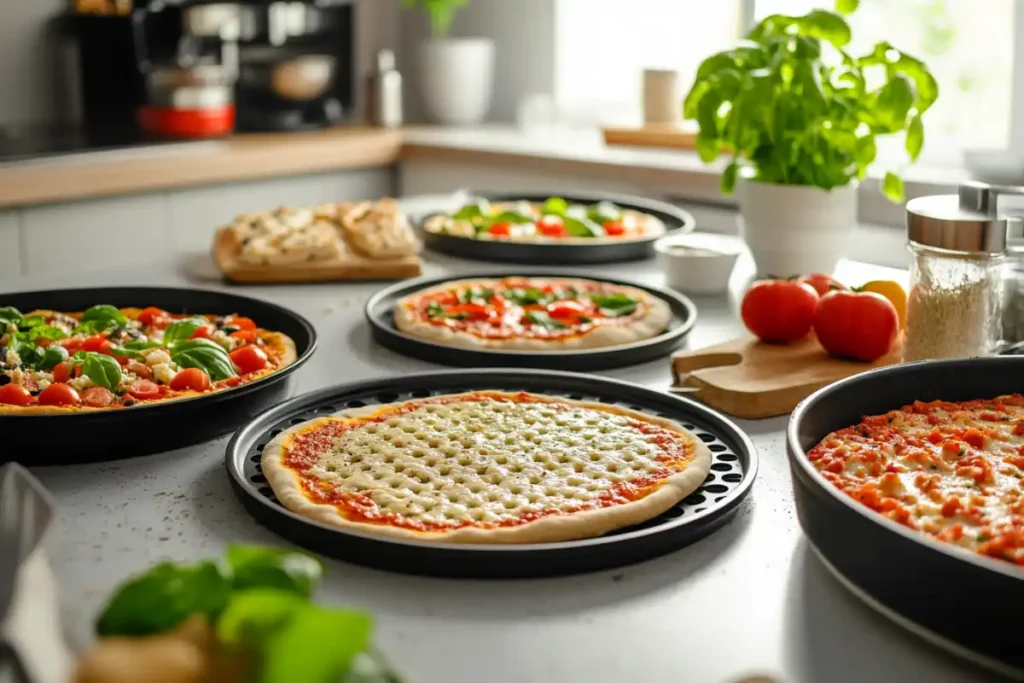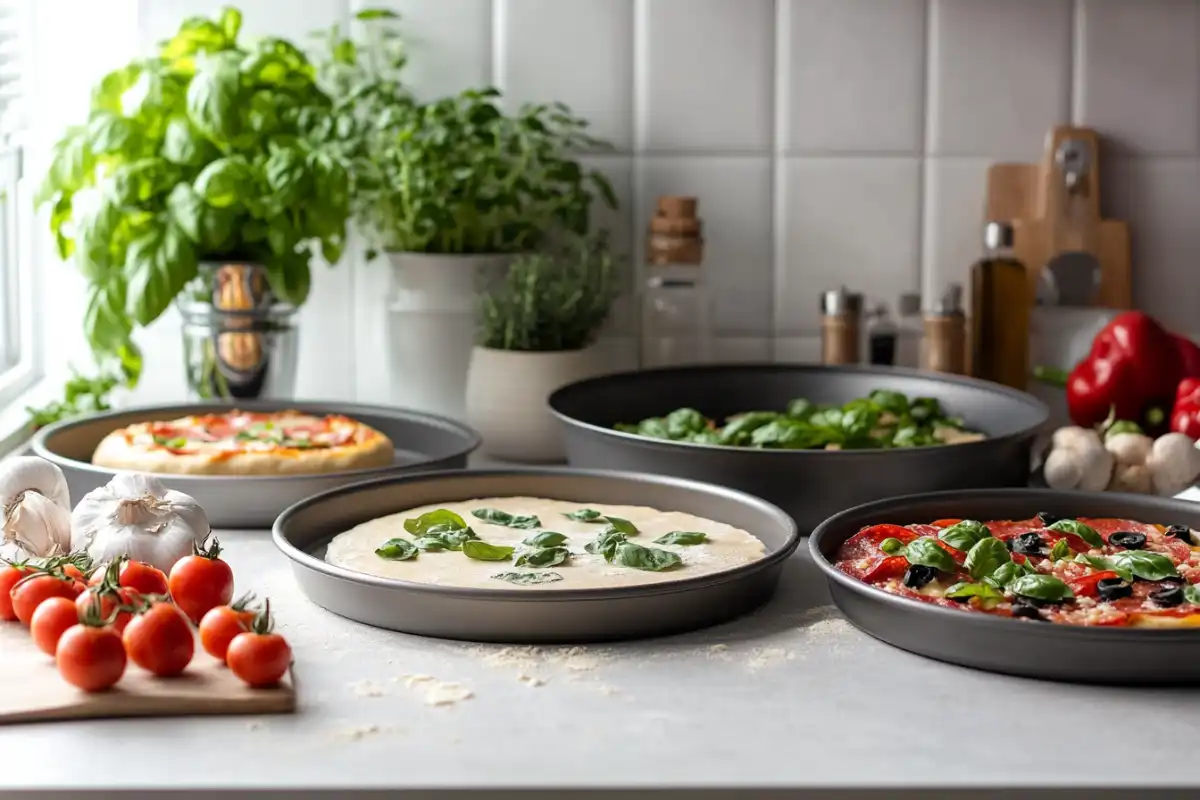Introduction
When it comes to making the perfect pizza at home, choosing the right pizza pan can make all the difference. Whether you’re a seasoned home cook or a beginner, the right pizza pan will not only help you achieve that crispy crust but also elevate the overall texture and flavor of your pizza. From material to size and design, there are several factors to consider when selecting the best pizza pan for your needs.

In this article, we’ll dive into the details of pizza pans, covering everything from the different types available, the materials that work best for achieving that golden-brown crust, and tips on how to care for your pan to ensure it lasts. So, if you’ve ever wondered what type of pizza pan is best for your kitchen, or if you’re simply looking to upgrade your pizza-making gear, keep reading! By the end of this guide, you’ll have all the information you need to bake the perfect pizza every time.
What is a Pizza Pan?
A pizza pan is a flat, round, or sometimes square baking tray that is specifically designed for making pizza. It serves as a sturdy surface to hold the dough, toppings, and cheese while it bakes in the oven. These pans come in various shapes, sizes, and materials, all tailored to achieve different results depending on your pizza preferences. Whether you’re a fan of crispy thin crusts, deep-dish, or anything in between, there’s a pizza pan out there that can help you get it just right.
The primary purpose of a pizza pan is to provide a flat surface for your pizza to bake evenly. This helps in distributing heat more efficiently, ensuring that your crust comes out perfectly crisp while keeping the toppings well-cooked. It’s an essential kitchen tool for anyone who enjoys making pizza from scratch or even baking frozen pizzas. But, choosing the right one? That’s where things can get a bit tricky.
Why Choosing the Right Pan Matters
Selecting the right pizza pan is more important than you might think. A good pizza pan ensures your pizza bakes evenly, helping to avoid soggy crusts or burnt edges. The wrong pan can also lead to uneven cooking, with some areas of the pizza being undercooked while others may be overdone. By picking the right type and material for your cooking style, you can create a much better pizza experience overall.
Moreover, the right pizza pan can also impact how crispy your crust becomes. If you’ve ever baked a pizza at home and found that the crust was too soft or soggy, it could have been due to using the wrong pan. Perforated pizza pans, for example, are designed with holes to allow more air circulation, giving you that crispy, restaurant-style crust. So, whether you’re a fan of crispy, chewy, or thick crust, the pizza pan you choose plays a key role in how your pizza turns out.
The good news? We’ve broken it all down for you, so by the end of this guide, you’ll have a solid understanding of which pizza pan suits your needs best and why. So, let’s dive deeper into the different types of pizza pans out there!
Types of Pizza Pans
When it comes to selecting the right pizza pan, the first thing you’ll notice is the wide variety available. Each type of pizza pan has its unique features, designed to enhance a particular style of pizza. Some pans are better for achieving a crispy, thin crust, while others excel at baking thick, doughy pizza. Understanding the different types of pizza pans will help you pick the one that best fits your cooking needs and preferences.
Round Pizza Pans
The classic round pizza pan is what most people envision when they think about making pizza at home. This style of pan is ideal for most home bakers and is versatile enough to cook a wide range of pizza types. Whether you’re baking a traditional Margherita pizza or a more elaborate creation, a round pizza pan gives you a consistent shape and uniform baking.
One of the key benefits of a round pizza pan is its ability to heat evenly, providing a balanced cook for your pizza. Most round pans are designed to hold the dough securely, so you don’t have to worry about it sliding off the edges. In addition, the round shape is perfect for achieving that desirable, evenly-baked crust around the entire pizza.
However, it’s worth noting that round pizza pans are not the best for every pizza style. If you’re more into deep-dish or Sicilian-style pies, you may want to consider other options. But for traditional, everyday pizzas, a round pan is often a go-to choice.
Square Pizza Pans
While round pizza pans are the traditional favorite, square pizza pans are gaining popularity among home cooks, particularly those who like their pizza with a bit of a twist. Square pizza pans allow you to cut the pizza into squares, which is perfect for serving multiple people or for pizza parties. The edges of square pans can create slightly thicker crusts at the corners, which some pizza lovers find appealing.
One of the main benefits of a square pizza pan is the even distribution of dough, especially if you’re making a Sicilian-style pizza. The pan’s corners allow you to spread the dough out more evenly, giving you a perfectly uniform base. Additionally, a square pizza pan fits more easily in square or rectangular ovens, making it a practical choice for some home bakers.
That said, the square shape may not be ideal for everyone. Traditionalists often argue that round pans give a more authentic pizza experience. Still, if you’re looking to switch things up or need a pizza for a group, a square pizza pan might just be your best bet.
Deep-Dish Pizza Pans
For fans of thick, hearty pizza, deep-dish pizza pans are a must-have. These pans are much deeper than traditional pizza pans, allowing for a thicker crust and a larger amount of toppings. If you’re someone who loves Chicago-style deep-dish pizza with layers of cheese, sauce, and toppings, then a deep-dish pizza pan is the perfect choice.
A deep-dish pizza pan is typically made of metal, which helps it retain heat and bake the crust to a crispy finish. The sides of the pan are often angled, which helps to build up the crust’s height. This pan type ensures your pizza has a substantial, fluffy crust with room for plenty of sauce and cheese.
While deep-dish pizza pans are great for those thicker pizza styles, they’re not the best for creating the thin, crispy crusts that some pizza lovers crave. Additionally, they may take a little longer to cook, as the deeper dish requires more time to heat through.
Pizza Pans with Holes (Perforated Pizza Pans)
If you’re a fan of a crispy, golden-brown crust, you’ll want to consider investing in a pizza pan with holes. These perforated pans have tiny holes all over the surface, allowing heat to circulate more evenly around the pizza, which results in a crispier crust. The holes let moisture escape, preventing the pizza from becoming soggy while baking.
Pizza pans with holes are particularly popular among people who bake thin-crust pizzas. These pans give you a light, crispy finish, especially if you’re baking a pizza with a thin layer of dough. The airflow through the holes helps to create that delicate, crunchy crust that many pizza lovers adore.
However, it’s important to keep in mind that these perforated pans might not be the best for thicker pizza crusts or those looking for a soft, chewy base. The holes are ideal for allowing moisture to escape, but they can also cause thicker doughs to bake unevenly. If you prefer a chewy crust, a solid pan might be a better option.
Materials Used
When you’re choosing a pizza pan, the material plays a big role in how your pizza will turn out. Different materials offer unique benefits in terms of heat distribution, cooking time, and the final texture of your pizza. The right choice can help you achieve a crisp crust, evenly cooked toppings, and an overall better pizza. Let’s explore the most common materials used in pizza pans and how they affect the baking process.
Aluminum
Aluminum pizza pans are widely popular for home cooking, and for good reason. They are lightweight, inexpensive, and heat up quickly, making them great for even cooking. The efficient heat conduction allows you to achieve a crispy crust without overbaking the toppings.
One of the advantages of aluminum pans is their non-stick surface. This feature makes cleanup easier, so you don’t have to worry about dough sticking to the pan. However, aluminum pans do have their drawbacks. They can warp under high heat, and if you bake at very high temperatures often, these pans may wear out more quickly.
Though aluminum pizza pans are affordable and versatile, they may not last as long as other materials. They are a solid choice for casual bakers who bake at moderate temperatures but might not be the best for frequent high-heat cooking.
Steel
For a sturdier and more heat-retentive option, try a steel pizza pan. Steel retains heat better than aluminum, which helps bake your pizza more evenly. The result? A crisp, perfectly cooked crust every time. Unlike aluminum, steel pans are much less likely to warp over time.
However, steel pizza pans don’t heat up as quickly as aluminum. You’ll need to preheat the pan to ensure even cooking. Steel pans also tend to be heavier than their aluminum counterparts, so they might be a bit harder to handle. But their durability and consistent results make them a great choice for serious home bakers.
If you want durability and an even cook, steel pizza pans are worth the investment. They’re perfect for anyone who takes their pizza making seriously.
Cast Iron
For ultimate heat retention, go with a cast iron pizza pan. Cast iron can handle extreme temperatures, which is perfect for achieving that crisp, golden crust. These pans distribute heat evenly, ensuring a balanced bake throughout. They’re a favorite among pizza enthusiasts for their ability to cook thick-crust pizzas to perfection.
The great thing about cast iron pizza pans is their durability. With proper care, these pans can last for generations. They develop a natural non-stick surface over time, especially when seasoned. However, the weight of the cast iron can make the pan difficult to handle. It’s also important to avoid soaking the pan to prevent rust.
While cast iron pizza pans are heavy and require special care, they offer fantastic results. The crispness and consistency they provide make them a great option for anyone serious about pizza.
Ceramic
If you prefer a more elegant approach to pizza making, ceramic pizza pans offer both beauty and functionality. Ceramic distributes heat evenly, ensuring that your pizza bakes uniformly. It also retains heat well, keeping your pizza warm longer after it comes out of the oven.
Ceramic pans are naturally non-stick, which makes cleaning up a lot easier. However, they can be fragile. If you’re not careful, a ceramic pizza pan could crack or chip. Despite this, the consistent bake and aesthetic appeal make ceramic a good choice for casual pizza makers.
Although ceramic pizza pans aren’t ideal for high-heat baking, they provide an excellent balance of performance and appearance. If you value even cooking and style, they are a great option.
Stone
For the closest thing to an authentic brick oven, try a stone pizza pan. These pans excel at creating that perfectly crisp crust. They absorb moisture from the dough, which results in a crunchier, lighter base. Stone pizza pans are excellent at holding heat, giving your pizza the crispiness and texture you’d find in a pizzeria.
To use a stone pizza pan, you’ll need to preheat the stone in the oven before placing your pizza on it. This process ensures that the stone reaches the perfect temperature for baking. While pizza stones require extra care (you should avoid washing them with soap), the results are worth the effort.
If you’re willing to put in the extra time and care, a stone pizza pan delivers some of the best results for crispy, brick-oven-style pizza.
FAQs
What is the best pan to cook a pizza in?
The best pan for cooking pizza depends on your preferences and the type of pizza you’re making. For a crispy crust, a pizza stone or cast iron pan works wonders, as they retain heat well and help achieve that crisp, golden finish. If you prefer a lighter, quicker cooking option, an aluminum pizza pan is a great choice. If durability is important to you, go for a steel pizza pan, as it offers even cooking and lasts longer. Ultimately, the best pan for you comes down to what kind of pizza you want to make and your cooking habits.
Is a pizza pan with holes better?
Yes, a pizza pan with holes can be better for achieving a crispier crust. The holes allow for better airflow during baking, letting moisture escape from the dough and preventing sogginess. This is especially beneficial when you’re making thin-crust or deep-dish pizzas, where you want the crust to stay crisp. While not necessary for all pizza styles, pizza pans with holes are a great option if you prefer a crispy base.
Do you flour or oil a pizza pan?
Both flour and oil are commonly used when preparing a pizza pan, and each has its advantages. Flouring the pan can help prevent sticking and gives your pizza dough a nice, lightly browned texture. On the other hand, oiling the pan helps to create a crispy crust and adds a bit of flavor. It also prevents the pizza from sticking. If you want extra crispiness, using oil is a good option. For a softer, less greasy crust, dusting the pan with flour is the way to go.
What is the best material for a pizza pan?
The best material for a pizza pan depends on your specific needs. If you want a pan that heats quickly and is easy to clean, an aluminum pizza pan is a solid choice. For even heat distribution and durability, a steel pizza pan is great. If you’re looking for the best crispiness and texture, a cast iron pizza pan is hard to beat. Ceramic pans offer an aesthetically pleasing option with even heat distribution, while stone pizza pans replicate the conditions of a brick oven for an authentic bake.
Conclusion

Choosing the right pizza pan is key to making a perfect pizza at home. Whether you prefer a crispy crust, a golden edge, or a soft and chewy base, the material and design of your pizza pan will influence the final outcome. From the quick-heating and non-stick properties of aluminum pans to the enduring durability of cast iron, each type of pan brings its own set of advantages to the table.
If you enjoy a crispy crust, a stone pizza pan or pan with holes might be the best option, while those looking for long-lasting durability might prefer steel or cast iron. Whatever your choice, the right pizza pan will help you elevate your pizza game and enjoy a delicious, homemade pizza every time.
Happy pizza making!

